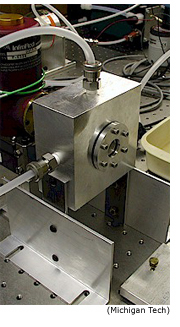|
|
| AST 392J · Astronomical Instrumentation |
 1
2
3
4
1
2
3
4

|
2.3 Segments and Segment Groups
The curriculum for this class has been divided into four segments. Each segment covers an important aspect
of instrument design and construction: mechanical design and fabrication, electronics and circuit design, optics
and optical design, and computer interfacing and software design. The segments will consist of a reading assignment,
a set of problems, some hands-on skill learning tasks and a laboratory excercise.
 The class will be divided into segment groups. Each group will rotate through the segments in
succession. Groups will have 3 weeks to complete each segment. You will do most of the activities as a group.
The class will be divided into segment groups. Each group will rotate through the segments in
succession. Groups will have 3 weeks to complete each segment. You will do most of the activities as a group.
2.4. Projects and Project Teams
A major aspect of this course will be the use of what you are learning to design and construct a working
instrument. The instrument project will consist of designing and building an optical spectrograph. This instrument
will have a solid-state optical detector and operate under computer control. It should be able to take
wavelength-calibrated spectra of bright emission-line sources (lamps).
You will carry out the project as a member of a project team. Each team will be responsible for
planning, designing, and building its own instrument. The members of your team will all come from
different segment groups so that your team quickly collects all of the skills neeed to carry out the project.
2.5. Assignments and Deadlines
Each segment will have a reading assignment, a set of paper exercises, a piece of software to master, a
practical exercise, and an evaluation/debrief. Because other groups will need access to the hardware,
your group must complete each section within the allotted time. The evaluations should be done individually
and handed in to the instructors. You should work out the paper exercises or problem sets on your own. You
may then consult with your group about the answers. Once you are sure you know the answer, you must hand
in your own writeup. Problem sets will be due at the end of each segment (note that, for the computer
interfacing segment, you will need to demo your knowledge rather than doing a problem set). Each project
team will have a preliminary review of their design and a final review of the project. At the two reviews, each
member of the team will be expected to be able to stand up and make any part of the presentation. At the
preliminary review, approximately six weeks before the end of classes, each team member will have to turn
in a written description of the instrument, how it will work, and how it will be built. This document should be
about two pages long, plus figures.
2.6. Class Meetings
In order to transfer information between the groups and teams and between these entities
and the instructors, to settle scheduling confilicts, and to provide an opportunity for making adjustments in the
material, we will have at least a brief class meeting each class day. Typically, about 30 minutes one day a
week will then be devoted to a class lecture/activity on an instrumentation topic. The other time will be used for
meetings of groups and teams, together with the Prof. or TA. Attendance at the meetings is a course requirement.
Do not be late for class. We will notice. ASTRONOMY GRAD STUDENTS: THIS MEANS YOU!!!
|
|
|
|

 The class will be divided into segment groups. Each group will rotate through the segments in
succession. Groups will have 3 weeks to complete each segment. You will do most of the activities as a group.
The class will be divided into segment groups. Each group will rotate through the segments in
succession. Groups will have 3 weeks to complete each segment. You will do most of the activities as a group.